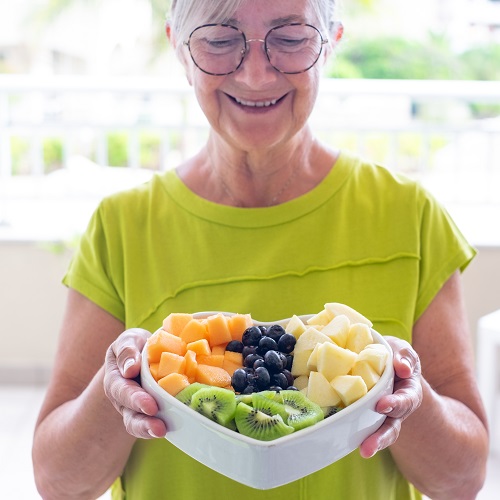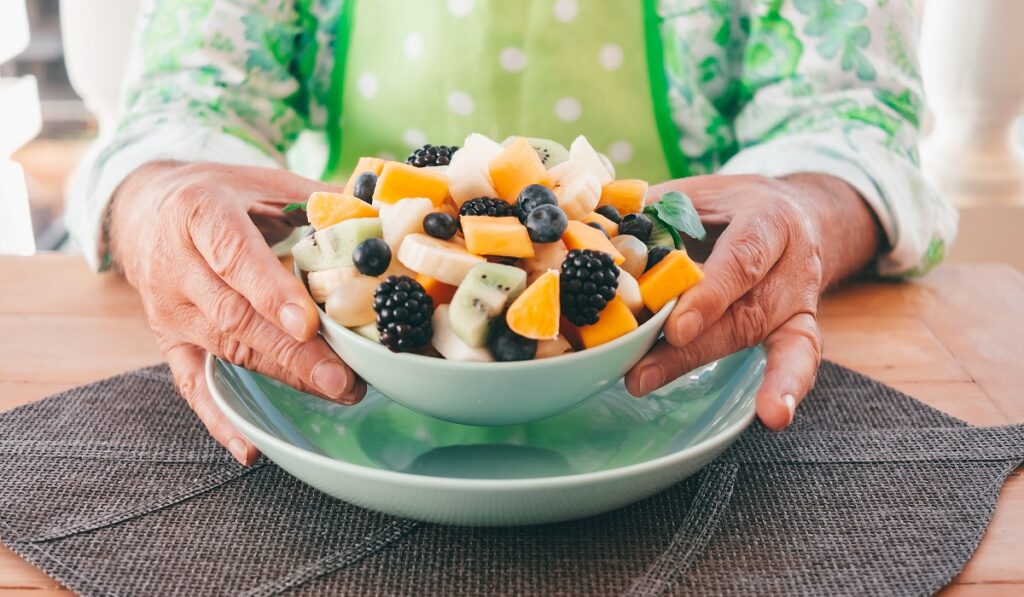Food for older adults after surgery isn’t just a health tip—it’s a recovery essential. If your aging parent is coming home after a hospital stay, you may be wondering what meals will actually help them heal. Post-surgery recovery in older adults often comes with reduced appetite, slower healing, and a higher risk of complications.
But the right food choices—like nutritious meals for recovery and proper hydration—can truly change outcomes. Older adults face increased nutritional demands during healing due to changes in metabolism and muscle mass. That’s why understanding what to eat after surgery and building healthy routines is so important.
In this article, we’ll share realistic, science-backed guidance on healthy eating for older adults, including the best foods for healing, what to avoid, and how senior living communities can play a vital role in supporting long-term recovery.

Key Takeaways
- Understand the role of food for recovery after surgery in healing
- Learn what healthy eating for older adults really looks like during recovery
- Get practical examples of what to eat after surgery and what to avoid
- Discover how senior living communities support long-term recovery
- Access expert tips and nutritional guidance that actually work
Why Nutrition Is Crucial After Surgery in Older Adults
Recovery doesn’t begin and end in the operating room. For older adults, healing continues at home or in a care setting—and nutrition plays a central role in that process. As we age, the body naturally becomes less efficient at healing: wounds take longer to close, inflammation lasts longer, and the immune system weakens.
What many families don’t realize is that recovery unfolds in distinct stages:
- Day 1 to 3: The body focuses on managing inflammation and preventing complications like infection or clotting.
- Day 4 to 14: Tissue repair begins, which demands more protein, vitamins, and hydration to rebuild strength and promote healing.
- Week 3 and beyond: Long-term recovery requires continued nutrient intake to restore endurance, mobility, and immune strength.
This is why choosing the right food for older adults after surgery is not optional—it’s essential. Meals must be nutrient-dense, rich in protein, vitamins, and fluids that support the body’s natural recovery systems. This includes healthy eating for older adults that’s tailored to their digestion and physical energy levels.
In senior living communities, this kind of care is built into the daily routine. Dietitians create nutritious meals for recovery with textures and portions adapted to post-surgical needs. Caregivers monitor intake, watch for signs of poor appetite or weight loss, and offer hydration and mealtime assistance. For families at home, maintaining this structure is often difficult—especially when juggling medication schedules, mobility challenges, and emotional needs.
Best Healing Foods for Older Adults After Surgery
During the recovery period, food for older adults after surgery must be more than soft or easy to eat—it needs to actively support healing. That’s where high-protein foods play a leading role. Protein helps rebuild tissue, close wounds, and prevent muscle loss—a common issue among older adults.
Older adults require 1.2 to 2.0 grams of protein per kilogram of body weight per day after surgery—nearly double the needs of a healthy younger adult.
Here are the best foods for healing that are easy to prepare, digest, and enjoy during recovery:
Protein-Rich Foods That Repair Tissues
- Scrambled eggs
Soft, versatile, and packed with high-quality protein. Eggs are gentle on digestion and easy to enrich with healthy add-ons like mashed avocado or cooked spinach. A great choice for breakfast or a light evening meal. - Baked or poached fish (e.g., salmon, cod)
These options offer lean protein and are rich in omega-3 fatty acids, which help reduce inflammation—a critical step after surgery. Pair with steamed veggies or mashed sweet potato for a healing, nutrient-dense plate. - Soft tofu or tempeh
Ideal for those preferring plant-based options, tofu is mild and blends well into soups, broths, or stews. It’s also rich in iron and calcium, which support tissue repair and bone strength. - Greek yogurt
Offers a double benefit: high protein and probiotics to aid gut health, which can be compromised by pain medications. Enjoy it plain, in smoothies, or mixed with soft fruits like bananas or berries. - Shredded chicken in soups or purees
Lean, easily digestible, and rich in protein. Chicken can be slow-cooked and blended into broths, making it ideal for lunch or dinner.
Fruits and Vegetables Rich in Vitamins and Antioxidants
When recovering, the body needs more than protein—it needs a full spectrum of nutrients to fight inflammation, repair tissue, and restore immune function. That’s where fruits and vegetables come in. These foods are rich in antioxidants, vitamins, fiber, and hydration—everything essential to healthy eating for older adults during recovery.
For older adults, appetite often declines post-surgery. That’s why it’s important to choose produce that’s flavorful, easy to prepare, and gentle on digestion.
Top Vitamin-Packed Foods for Recovery
- Berries (blueberries, strawberries)
Rich in vitamin C and powerful antioxidants, berries help reduce inflammation and support the immune system. They’re also naturally sweet and easy to serve in smoothies, oatmeal, or yogurt—making them one of the best foods for healing that seniors will actually enjoy. - Steamed carrots and spinach
Both are soft, nutrient-dense, and easy to digest. Carrots provide beta-carotene for skin and tissue repair, while spinach adds vitamin K for blood clotting and bone health. Serve them as purees, soups, or soft sides. - Pumpkin and sweet potatoes
These orange vegetables are loaded with vitamin A, a key nutrient for healing and immune function. Mashed pumpkin or sweet potato offers fiber and slow-releasing carbohydrates, giving the body energy without stressing the digestive system. - Avocados
Often overlooked, avocados deliver healthy fats, vitamin E, and potassium—all crucial for cell repair and hydration. They’re also ideal for spreading on soft toast, blending into smoothies, or topping protein bowls.
In senior living communities, caregivers understand that food for older adults after surgery must be both functional and enjoyable. That’s why they incorporate these healing fruits and vegetables into daily menus—pureed when needed, cooked soft, and seasoned to improve palatability. Meals are planned not just for nutrients, but also for presentation and taste—important factors in stimulating appetite in recovering residents.
Soft Foods That Are Easy to Digest
After surgery, the digestive system often slows down, and soft foods are recommended to prevent discomfort. Some good options include:
- Mashed potatoes – Gentle on the stomach and can be fortified with butter or olive oil for calories.
- Vegetable soups – Provide hydration, nutrients, and are easy to consume. Excellent for those with a low appetite.
- Oatmeal – High in fiber, low in fat, and easy to personalize with fruits or protein powder.
- Applesauce – Naturally sweet and easy to digest. Can be used as a snack or side.
- Rice or quinoa bowls with soft veggies – Offer energy and nutrition. Customize for flavor and texture.
Hydrating Foods and Fluids That Speed Up Recovery
Hydration is often overlooked but absolutely essential. Dehydration can slow wound healing, worsen fatigue, and affect medication absorption. These foods and fluids help:
- Watermelon – Refreshing and high in water content. Often served as a snack or dessert.
- Cucumber – Low in calories and soothing for digestion. Add to salads or infuse in water.
- Bone broth – Provides electrolytes and mild protein. Excellent for sipping throughout the day.
- Herbal teas – Warm and comforting, especially beneficial for sleep and digestion.
Healthy Eating Tips for Older Adults During Recovery
Good habits are just as important as food choice. Here are key eating tips:
- Smaller, more frequent meals – Avoid overwhelming the digestive system.
- Warm, soft-texture foods – Easier to chew and digest.
- Use high-calorie boosters – Add olive oil, peanut butter, or dairy where appropriate.
- Avoid skipping meals – Even small meals help maintain energy.
Foods to Avoid After Surgery
Some foods can delay healing, cause bloating, or interfere with medications. Here’s what to avoid and why:
- Processed meats (like bacon or sausages) – High in sodium and preservatives that increase inflammation.
- Fried or greasy foods – Harder to digest and may cause nausea or discomfort.
- Sugary snacks and desserts – May lead to energy spikes and drops; also fuel inflammation.
- Carbonated drinks – Cause bloating and may interfere with medication absorption.
- Alcohol and excess caffeine – Lead to dehydration and can strain organs already under stress.
In senior living settings, these foods are naturally limited or excluded. Residents receive guidance on dietary restrictions from licensed dietitians, ensuring they stay on track with recovery.
How Senior Living Supports Nutrition After Surgery
Senior living communities offer a structured, professional environment where nutritional recovery is part of daily care. While home caregivers do their best, it’s often overwhelming to manage everything alone.
In these communities:
- Meals are created by certified dietitians who understand post-surgical needs
- Trained staff ensure residents are hydrated and consuming enough calories
- Emotional support is available during mealtimes, which can increase appetite
- Progress is tracked and adjustments are made quickly if healing slows
Additionally, residents receive guidance on supplement use, medication timing, and appetite management—all key to recovery.
What Helps and What to Avoid
In addition to eating well, recovery involves movement, rest, and emotional care. Here’s a simplified breakdown of helpful vs. harmful activities:
| Helpful After Surgery | Avoid After Surgery |
| Light walking (5–10 minutes, several times a day) | Heavy lifting or bending forward |
| Gentle stretching with caregiver supervision | Twisting motions or high-impact movements |
| Daily hygiene routines (with assistance if needed) | Skipping personal care (risk of infection) |
| Short periods of social interaction | Prolonged isolation or inactivity |
| Scheduled rest and sleep routines | Staying in bed all day without movement |
In senior living environments, these guidelines are embedded into daily life. Staff assist with mobility, ensure proper hygiene, and create social opportunities that reduce stress and loneliness—both of which impact recovery speed.
Conclusion
Healing after surgery takes more than time—it takes structure, nourishment, and consistent support. With the right food for older adults after surgery, recovery becomes safer and more effective. From high-protein meals to hydration and emotional care, these elements work together to rebuild strength, reduce complications, and support a return to daily life.
If you’re looking for a residence where your loved one can recover comfortably after surgery and stay long-term to build meaningful relationships, contact us to schedule a tour. We are a senior living home located in Palm Beach Gardens.
Frequently Asked Questions About Food for Older Adults After Surgery
What is the best food to eat for healing after surgery?
Protein-rich foods like scrambled eggs, chicken, and Greek yogurt are best for tissue repair. Pair with soft fruits and vegetables for balanced recovery.
What are the best foods for elderly people?
Soft, nutrient-dense meals including lean proteins, steamed vegetables, whole grains, and hydrating fruits support strength, digestion, and overall wellness.
Why can’t you eat eggs after surgery?
Eggs are generally safe and beneficial. However, some may avoid them briefly due to nausea or dietary restrictions. Always follow a doctor’s guidance.
What is the one fruit all seniors should eat?
Blueberries—they’re rich in antioxidants, support brain and immune health, and are easy to eat in smoothies or yogurt.
What should an 80-year-old eat in a day?
Three balanced meals with protein, fiber, and healthy fats—plus snacks like fruit or yogurt. Hydration and variety are key to staying nourished.

